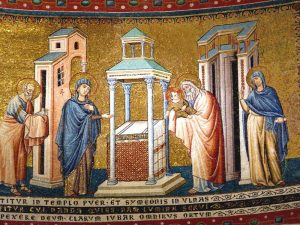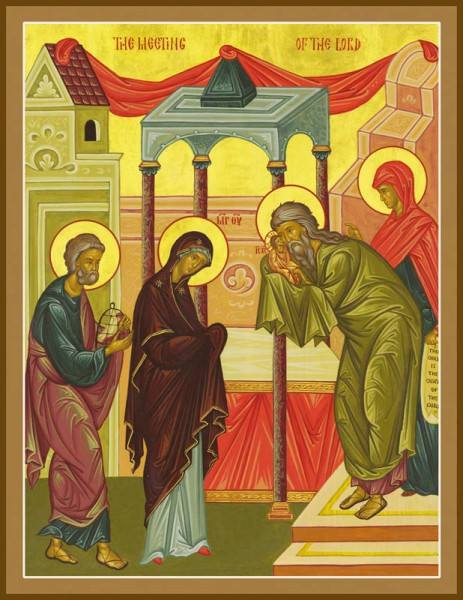 Today’s feast is also as known the Presentation of the Lord in the Temple of the Purification of Mary (Lk 2:22-40). The Liturgy of the Church prays:
Today’s feast is also as known the Presentation of the Lord in the Temple of the Purification of Mary (Lk 2:22-40). The Liturgy of the Church prays:
“The sacred Virgin offered the Sacred One in the Sacred Place to the Sacred Minister. Clasping Him in his arms, Simeon received Him with joy and cried out, ‘Now, Master, you release your servant, according to you word, in peace, O Lord.’ “ [From Vespers]
“Then one of the seraphim flew to me, holding an ember which he had taken with tongs from the altar. He touched my mouth with it. See, he said, now that this has touched your lips, your wickedness is removed, your sin purged.”
(From Isaiah chapter 6, the second Reading at Vespers of the Feast of the Encounter)
“Simeon spoke to the Mother of God, saying: one of the Seraphim purified the lips of Isaiah with a burning ember. You fill me with light as you entrust to me, with your hands as with tongs, the one whom you hold, the Lord of the light that knows no evening, and the King of peace.”
(Troparion at Glory, Ode 5, Canon of the Feast of the Encounter)
Simeon holds God in his arms, the burning coal inaccessible to our human nature, yet made flesh and able to be embraced in love. God is often described as a spiritual fire. He appears to Moses as the bush which burned but was not consumed, which in turn became an image of the Virgin Mary who bore the fire of the Godhead in her womb. The holy John the Baptist protested, “Who has ever seen the sun, that is radiant in its essence, being purified? How then shall I cleanse in the waters the one who is the brightness of the glory, the Image of the everlasting Father? How shall I, who am like straw, touch the fire of your divinity with my hand? For you are Christ, the wisdom and power of God. The Spirit comes upon the apostles in the form of tongues of fire.” (1st Troparion, Ode 4, Canon of Theophany)
The Spirit comes upon the apostles in the form of tongues of fire. God is the light of knowledge and understanding and the fire of love. How can we dare to touch him and live? Simeon holds him and cries out, “Now you may dismiss your servant!” Yet we do, and Holy Communion is called the “coal” in some Eastern Christian traditions, the ember that purified the lips of Isaiah. God cleanses us from our sins and makes us worthy to receive him more intimately than Simeon, in our lips and in our body. We receive Communion “for the forgiveness of sins and life everlasting.” As we celebrate this feast, we can never comprehend this gift.
![]() Tomorrow, February 2, is the feast of the Encounter of Our Lord and Savior Jesus Christ. The Divine Liturgy with the Blessing of Candles will be offered at 9:00 a.m. in both English and Ukrainian. This day is a holy day of Love.
Tomorrow, February 2, is the feast of the Encounter of Our Lord and Savior Jesus Christ. The Divine Liturgy with the Blessing of Candles will be offered at 9:00 a.m. in both English and Ukrainian. This day is a holy day of Love. “The Lord said to Moses on that day he brought the sons of Israel out of the land of Egypt. He said: Consecrate to me every firstborn; whatever opens the womb among the Israelites” (Exodus 12:51). In this feast, the last of the Christmas cycle, the Feast of Light, Mary and Joseph bring the child Jesus to the temple to fulfill this commandment.
“The Lord said to Moses on that day he brought the sons of Israel out of the land of Egypt. He said: Consecrate to me every firstborn; whatever opens the womb among the Israelites” (Exodus 12:51). In this feast, the last of the Christmas cycle, the Feast of Light, Mary and Joseph bring the child Jesus to the temple to fulfill this commandment. Today’s feast is also as known the Presentation of the Lord in the Temple of the Purification of Mary (Lk 2:22-40). The Liturgy of the Church prays:
Today’s feast is also as known the Presentation of the Lord in the Temple of the Purification of Mary (Lk 2:22-40). The Liturgy of the Church prays: